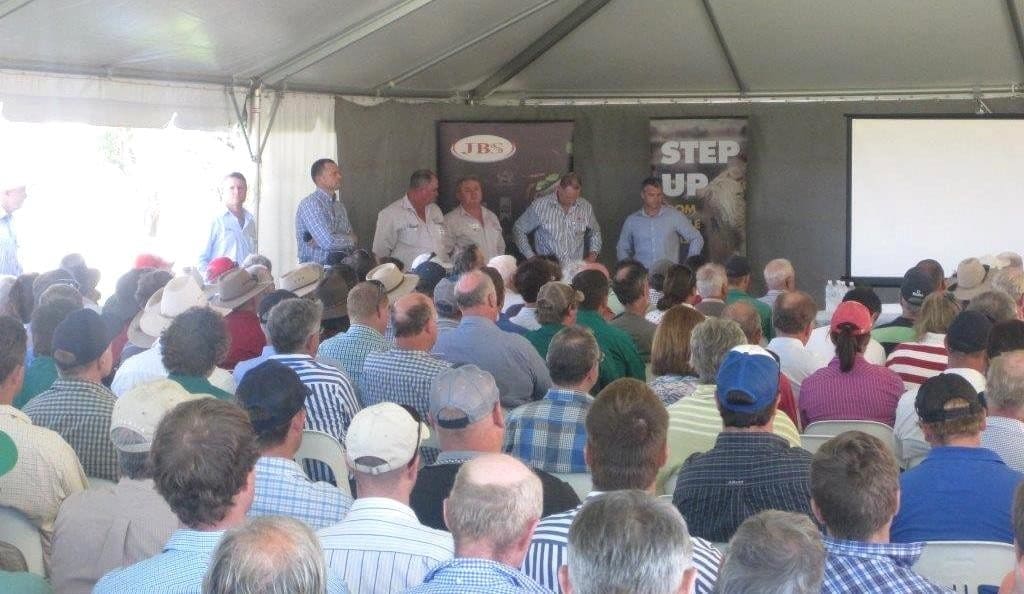THE first livestock bought under JBS Australia’s new pre-vaccinated feeder cattle program are now on-feed in the company’s three New South Wales feedyards.
JBS in early December launched a pre-vax feeder cattle program (click here to view Beef Central’s original article) offering a $15 producer incentive for appropriately pre-vaccinated feeders.
While pre-vax programs have been tried before across the feedlot industry, the latest more simplified version (a single vaccine applied by producers only once) is overcoming much of the earlier resistance to more complicated schemes.
Beef Central compiled this earlier report on the advancement of pre-entry feeder cattle vaccination programs, including a history of past failures in this article published in December.
Discussions around pre-vax were one of the drawcard topics that drew about 550 NSW and Victorian producers to three producer open days hosted by JBS recently at its southern feedlots at Caroona, Riverina and Prime City. The Prime City event was tailored specifically for suppliers of Shorthorn-derived cattle, being directed into JBS’s new as-yet unnamed Shorthorn beef niche brand.
The southern feedlot open days followed five similar producer gatherings in Queensland late last year, stretching from Cloncurry to Roma.
While a range of topics including international market outlook (covered in a separate article tomorrow) and cattle supply and demand were covered on the day, there was also lots of discussion and questions focussed on the company’s new pre-vax program.
The first of the feeder steers bought under new pre-vax incentives were inducted at Prime City and Riverina on January 4, meaning they have now had about six weeks on feed.
While supply of feeder steers generally across the industry has been tight this year, JBS said it was happy with the rate of uptake of the new program, at this early stage.
Some of the early lines of pre-vaccinated feeders have been larger mobs, including 400 steers in one line from a single vendor.
Productivity, including growth rates, feed conversions and consumption, and morbidity/mortality rates will obviously be closely monitored as more pre-vaccinated cattle start coming through the system.
“It’s still early days, but we’ll be keenly watching the results in performance,” JBS manager livestock northern Duane Woodham said.
One of the key messages raised with producers was that given the dramatic rises in young cattle prices experienced over the past 12 months, and the desperate shortage of cattle generally in the pipeline following two years of continental-scale drought, it is now critically import to ensure that all cattle perform once they hit the feedyard.
“JBS will continue to look at all avenues to ensure optimum performance out of all of it’s livestock purchases,” Mr Woodham said.
There was also an underlying message in buyer attraction towards cattle that ‘consistently perform’ in the feedlot environment, following protection from respiratory illness.
Exactly what an appropriate level of reward for producers engaging in such programs has been the topic of some debate in earlier times, but there were no questions raised or comment from producers on the topic at any of the JBS producer days. JBS’s current offer of $15 a head for appropriately pre-vaccinated feeders is competitive with other similar industry programs (see earlier summary here). The vaccine itself costs about $7 a shot.
There was widespread acknowledgement at the open days that the industry’s latest attempt at pre-vaccination was a lot easier and simpler than earlier campaigns seen a decade or more ago.
The treatment applied (Bovilis MH+IBR) is now a single vaccine, which producers have to administer only once. Earlier schemes often required two separate vaccines and re-mustering and re-vaccination on-farm before consignment.
Mr Woodham said despite the general shortage of feeders available this year due to national herd decline, JBS would continue to secure its replacement feeder requirements for the company’s southern grainfed programs.
Apart from the pre-vaccination topic, JBS northern chief operating officer Anthony Pratt gave an outline of the state of the industry from a supply and demand perspective, and what the future looks like for the lotfeeding, processing and marketing of beef internationally.
He touched in the collective challenges that the Australian beef industry faces now, and into the future. More on that in a coming article.
- JBS circulated this briefing note to livestock suppliers on its pre-vaccination program offer this week.

